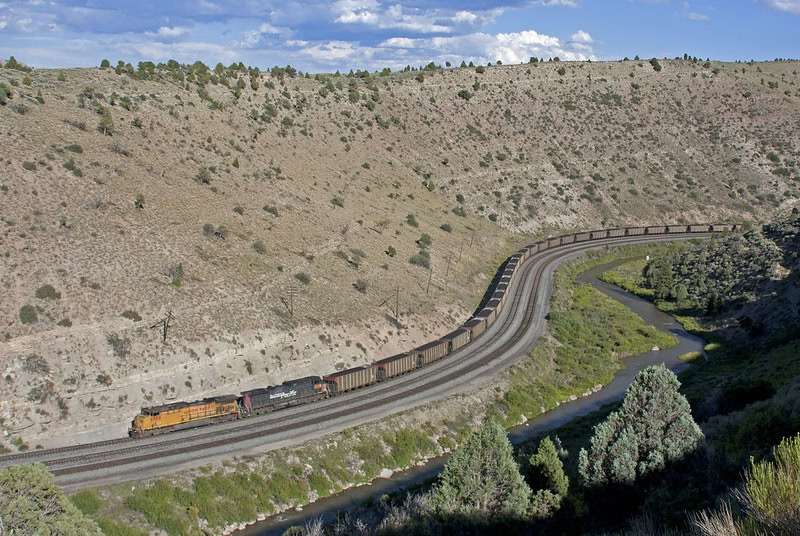Update 11th June – The Seven County Infrastructure Coalition is reviving its effort to finance the long-delayed Uinta Basin Railway following a favorable U.S. Supreme Court ruling last month. The coalition has approved a plan to apply for $2.4 billion in private activity bonds from the U.S. Department of Transportation—$500 million more than it sought in 2023.
The renewed funding effort comes after the Supreme Court overturned a federal appeals court decision that had blocked the Surface Transportation Board’s 2021 approval of the 88-mile rail project. The case now returns to the D.C. Court of Appeals for reconsideration under narrower environmental review requirements.
The planned bond issuance would cover roughly 70% of the estimated $3.4 billion construction cost, which has more than doubled from the $1.4 billion projected in 2020. However, the bond request faces a hurdle: the Department of Transportation has already allocated $29.4 billion of its $30 billion cap for private activity bonds, with no new authorization expected until a new transportation bill—likely not before late 2026.
A required public hearing on the bond resolution is set for June 12. The coalition hopes the project will finally move forward after years of legal and funding setbacks.
The Uinta Basin Railway project—an 88-mile rail line connecting Utah’s remote oil fields to the national rail network—has cleared a major legal hurdle. On May 29, 2025, the U.S. Supreme Court unanimously overturned a previous federal appeals court ruling, allowing the project to advance after years of legal and environmental challenges.
Background: What Is the Uinta Basin Railway Project?
Initially approved by the Surface Transportation Board (STB) in 2021 following a 3,600-page Environmental Impact Statement (EIS), the Uinta Basin Railway project is a public-private partnership led by several rural Utah counties and a Texas-based rail company. The line is expected to transport up to 350,000 barrels of waxy crude oil daily from the Uinta Basin through Colorado and to refineries on the Gulf Coast.
Economic Significance for Utah
Supporters argue that the Uinta Basin Railway project will be a major economic boost for northeastern Utah, which saw record oil production in 2024—65.1 million barrels, a 13% increase from the previous year. They believe the railway will expand market access for Utah crude and reduce the environmental impact of heavy trucking.
Environmental and Legal Opposition
However, environmental groups and communities in Colorado, particularly in Eagle County and along Glenwood Canyon, have strongly opposed the project. The legal battle revolved around the National Environmental Policy Act (NEPA). In 2023, the D.C. Circuit Court determined that the STB had failed to fully evaluate broader environmental consequences, including oil spill risks, wildfires, and long-term climate effects.

Hudson River rail tunnel project in New York, USA
Supreme Court Ruling on NEPA Interpretation
The Supreme Court disagreed with the appeals court and ruled that NEPA requires federal agencies to assess only the “proximate effects” of a project—such as the railway’s construction and operation—not downstream impacts from drilling or refining. Justice Brett Kavanaugh, writing for the majority, emphasized that NEPA is “a procedural cross-check, not a substantive roadblock.”
This interpretation limits the law’s reach and provides a clearer path forward for infrastructure projects like the Uinta Basin Railway project that face challenges related to extended environmental concerns.
Ongoing Political and Environmental Resistance
While environmental organizations like the Center for Biological Diversity condemned the decision as a “disastrous weakening” of environmental oversight, Colorado officials have also pushed back. State Attorney General Phil Weiser described the Uinta Basin Railway project as a “risky scheme,” and Representative Elizabeth Velasco labeled the ruling “catastrophic.” Velasco is sponsoring state legislation—currently awaiting the governor’s signature—to bolster rail safety oversight within Colorado.
What’s Next for the Uinta Basin Railway Project?
Despite the Supreme Court’s decision, the STB must still address remaining environmental concerns. Legal and political opposition continues, but for now, the Uinta Basin Railway project is back on track and represents a major development in the nation’s ongoing debate over energy infrastructure and environmental responsibility.
Project Timeline
- 2021 – Surface Transportation Board approves the project after releasing a 3,600-page EIS.
- 2023 – D.C. Circuit Court strikes down STB approval, citing insufficient environmental review under NEPA.
- 2024 – Utah’s Uinta Basin hits record oil production (65.1 million barrels).
- May 29, 2025 – U.S. Supreme Court overturns D.C. Circuit decision, allowing the project to proceed.
- Ongoing (Post-May 2025) – STB must resolve outstanding environmental concerns; state-level and activist opposition continues.

